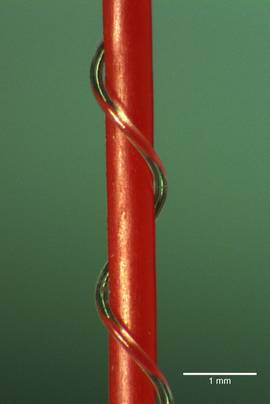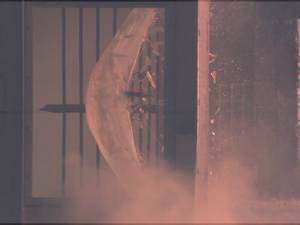Creating Bomb-proof Curtains
Interview with
Chris - Also in the news this week, a new type of material, one that gets thicker rather than thinner when you stretch it, this is called an 'auxetic' material is being developed by EPSRC fund of researchers and they're trying to provide better protection from the effects of bomb explosions. Jane Reck spoke to the inventors who are based at Exeter University.
Jane - In this research laboratory, cutting-edge science and technology is getting a helping hand from an old fashion machine, a traditional craft loom. But instead of weaving cotton for clothing, it's making a completely new type of fabric. It's a material that will give much better protection from the effects of bomb explosions and severe weather events such as typhoons and hurricanes. The project uses auxetic materials and is led by Professor Ken Evans at the University of Exeter.
Ken - An auxetic material is unusual in that it's a material which when you pull it, does something that you would not normally expect. If you imagine pulling a rubber band, two things obviously happen when you pull it. It gets longer and at the same time it gets thinner, and this is a very easy thing to see with a piece of rubber, but that's the fact with the case of any material. If you could pull a piece of steel, you would find it was getting thinner as it was getting longer. Well auxetic materials do exactly the opposite. When you pull them they get longer but at the same time they get fatter. This particular project is about blast mitigation. It's about using auxetic materials to make a textile which we can then produce a curtain material from which will act to mitigate blasts in an explosion situation. And auxetic materials we believe have particular characteristics that will mean that they absorb energy much more effectively than the current conventional materials.
Jane - The hands on work of identifying which materials need to be used, the manufacturing and testing of the yarns, and analysing the results of those tests is carried out by Dr. Mike Sloan.
Mike - The really useful thing about this research is that we're taking conventional fibres. So these are fibrous materials you can buy off the shelf, so you're talking about stretchy materials, elastomeric materials like polyurethane and then you're combining it with a higher performance fibre like Dyneema, people probably have heard of that. Also, ultra high stiffness carbon fibres and it's the method in which we combine and it gives you auxetic effects. So it's conventional materials in a helical arrangement that gives the auxetic effect and there's a number of parameters we can change. We're looking at the stiffness ratio between the two fibres and also the angle at which the second fibre is wrapped around the middle fibre.  We designed and built a purposely designed spinner here at Exeter and we can load our core fibre onto a single-spool feed spool that's taken up at the end on a take-up spool. And we just program in the relative speeds of the actual spools and that will manufacture a yarn - very accurately controlling what we called the 'wrap angle' so how tightly the wrap fibres wrapped around the core fibre. Then that yarn will then go back to the mechanical testing machine and I'll add on some extra hardware that we've got and will characterise its mechanical performance, but also shape change, how auxetic is it.
We designed and built a purposely designed spinner here at Exeter and we can load our core fibre onto a single-spool feed spool that's taken up at the end on a take-up spool. And we just program in the relative speeds of the actual spools and that will manufacture a yarn - very accurately controlling what we called the 'wrap angle' so how tightly the wrap fibres wrapped around the core fibre. Then that yarn will then go back to the mechanical testing machine and I'll add on some extra hardware that we've got and will characterise its mechanical performance, but also shape change, how auxetic is it.
When it gets this much longer, how much wider does it get? Then those most promising yarns will go forward onto our loom. The loom that we actually use is designed and sold as a craft loom. There's nothing special that we've done to the bit of equipment. There's no modifications that we've made. The only thing we do is these are auxetic yarns to make an auxetic textile, and by using a computer controlled software on the loom, we can actually change the weave pattern as well so we can go from a straightforward, what we call a 'checkerboard weave' right up to complicated twill weaves. It's at another parameter that we can change using the loom as well.
Jane - A crucial part of the design process involves the computer modelling work carried out by Julian Wright, a research fellow at the university.
Julian - If we want to make enough yarn to make a curtain-sized piece of fabric for example, that will be several hours' worth of time. So that's a very expensive mistake if we don't get the yarn right at the design stage. That's a key facet of the computer modelling, is to be able get the yarn right without actually having to spend hours making it and then seeing it if it was right. We want to know it's going to be right when we've made it. The computer modelling at this stage is concentrated on the yarns. So we're not yet modelling the textiles and we're certainly not yet modelling the explosions. We're specifically interested in how will the yarn behave when we stretch it, how fat do we need to make it, how stiff do we need to make one or more of the components, what angle do we have to wrap the helical component at, how far can we pull it. One of the major parts of the modelling activity at the moment is to be able to predict the behaviour of the yarn from a knowledge of the two components. We know what polyurethane's like. We know what polyamide is like for example. What we would like to know is if we wrap those two together, how will they behave? The major achievement so far of the research certainly in the context of computer model is that we now have very detailed knowledge. We understand very well how to design a helical auxetic yarn.
Jane - The tests that the team have used to put the material through its places show that the shockwave from a bomb blast travels more than 1500 miles per hour. Ken and Mike explain what the tests have shown.
 Ken - The very first thing you see is the light that comes from the blast, and then a pressure wave arrives from the explosion, and that moves the curtain inwards as you might expect it to do. And then following on from that, you then get destructive damage. So if you have a glass window, the glass shatters and breaks. Now what happens is the curtain is moved by the pressure wave first and because our fabric is auxetic, it opens out in a particular way. The curtain at that stage is not damaged by the blast at all. So the glass fragments then arrive after the pressure wave and are essentially captured by the curtain. And at this point, the curtain starts returning to its original shape. It stops ballooning out. It moves back in the other direction. And in fact, what we see is the glass fragments collected and essentially thrown back, almost like a trampoline effect, back out of the room. So you can see the energy absorbing mechanisms taking place while this process is going on, and what's been particularly useful is to be able to do the test with very high speed cameras to see exactly what the mechanisms are, so we can understand how the total process works.
Ken - The very first thing you see is the light that comes from the blast, and then a pressure wave arrives from the explosion, and that moves the curtain inwards as you might expect it to do. And then following on from that, you then get destructive damage. So if you have a glass window, the glass shatters and breaks. Now what happens is the curtain is moved by the pressure wave first and because our fabric is auxetic, it opens out in a particular way. The curtain at that stage is not damaged by the blast at all. So the glass fragments then arrive after the pressure wave and are essentially captured by the curtain. And at this point, the curtain starts returning to its original shape. It stops ballooning out. It moves back in the other direction. And in fact, what we see is the glass fragments collected and essentially thrown back, almost like a trampoline effect, back out of the room. So you can see the energy absorbing mechanisms taking place while this process is going on, and what's been particularly useful is to be able to do the test with very high speed cameras to see exactly what the mechanisms are, so we can understand how the total process works.
Mike - Not only have we watched the blasts under high speed video. We got pressure sensors before and after the curtains and the two things that are really interesting are the peak pressures that we measure, but also the time duration, and when you take the area around of that curve, you get what we call the 'impulse' and that's really the energy that's experienced as a function of the blast. And our preliminary data are showing that curtains give a 25% reduction in that impulse. So the 25% reduction of the energy that somebody the other side of the window would experience, so it's looking really promising, and you know, we can only go forwards from here.
Jane - Ken hopes it won't be too long before we see the fabric in general use.
Ken - I would say that within 5 years, you could see commercial fabric on the market, providing they meet the promise that we believe they're going to do.
Chris - That was Ken Evans, Mike Sloan, and Julian Wright from the University of Exeter and they were talking to the EPSRC's Jane Reck.
&nb
| Expanding blast-proof curtain will reduce impact of bomb explosions |










Comments
Add a comment